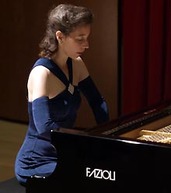
Canadian pianist Angela Hewitt has lived in Britain for many years – but she’s just finished up a visit to her homeland, with performances in Toronto and Ottawa. In Toronto, she played a recital on Sunday afternoon to a packed house at the Royal Conservatory’s Koerner Hall – an intriguingly mixed program of Bach and French repertoire.
Bach is, of course, a specialty of hers – and from the opening notes of the Allemande from the French Suite No. 4, it was apparent just how securely she inhabits this repertoire. The independence of her left and right hands brought depth to this music, and her sense of rhythm and tempo were invariably spot-on.
The individual movements each had their own character – the Courante was lively, the Sarabande rather inward-looking – and so the suite continued, in neat, fluid, and always very proper ways.
And there’s the rub: Hewitt has a way of taking propriety to a fault. As her recital unfolded, her performances – although consistently refined and aristocratic – could sometimes lack spontaneity, or the stamp of a distinctive musical personality. While there may be some listeners who may hold such pristine and lofty artistry in high regard, I was more impressed whenever Hewitt found her way down to earthly realms.
Unfortunately, this didn’t happen much in Fauré’s Ballade in F-Sharp Major. The lengthy and virtuosic work was a fine vehicle for Hewitt to display her masterful facility at the keyboard. But as her fingers rippled through treacherous passages with (apparent) ease, there was control and calculation in the ebb and flow of phrases. This is sentimental music, but Hewitt displayed little interest in emotional display – which was a shame.
More French music followed: Debussy’s L’Isle joyeuse. Here, her cool approach to interpretation became a virtue, and her performance was enriched with detail. There were even moments of grandeur here – although one such moment led to her missing the final note of the piece. (Perhaps CBC Radio 2, which was taping this recital for broadcast on Dec. 4, will find some way to patch up this little flub.)
Intermissions have a way of working wonders – and Hewitt’s return to the stage for the second half of the program came with a noticeable increase in intensity. Now, in Bach’s French Suite No. 5, her technical prowess was accompanied by a heightened sense of the music’s expressive potential.
For example, the Sarabande was both stately and contemplative, with very effective use of pianissimos. The famous Gavotte was delightful, and the Bourrée was marked by a firm sense of direction.
In the Louré, Hewitt stepped beyond the bounds of convention to display a strong personal voice. And the concluding Gigue was urgent and compelling – certainly the most exciting playing yet heard.
Yet more excitement would soon come, in Ravel’s Le Tombeau de Couperin. At the outset, Hewitt played it cool – but soon warmed things up in a touchingly fragile Forlane. The Rigadoun was tossed off at an astonishing tempo: a display of willful excess that was entirely welcome at this point. Following a sweetly introspective Menuet, her Toccata was a wild ride, full of bravura, colour and even some vivid grotesque elements.
Hewitt offered two encores: Debussy’s Golliwog’s Cakewalk and Claire de Lune. Both were crowd pleasers.
© Colin Eatock 2011
 RSS Feed
RSS Feed

